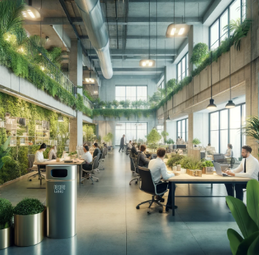|
by Adrian Guzman In the spirit of Carrie Bradshaw, let's stroll through the bustling streets of our minds and ponder - isn't Earth Day somewhat like the ultimate love story? A global rendezvous dedicated to celebrating and preserving the beauty of our planet. It's the kind of love story that, like the most memorable episodes of Sex and the City, mixes glamour with gritty reality, aspirations with practical actions. And in this narrative, we're not just spectators; we're leading characters passionate about making a lasting impact.
Through our efforts, we help transform workplaces and places of worship into exemplars of green innovation. We believe that sustainability transcends preserving the environment; it involves fostering a dynamic and flourishing space where businesses, communities, and the natural world harmoniously thrive. Green is the New BlackAdopting eco-friendly practices in the workplace isn't just a trend; it's a lifestyle—a commitment to a philosophy that champions the earth's well-being as much as it does productivity and profit. Imagine walking into an office where the walls are not just barriers but canvases showcasing the art of living walls—plants breathing life into the space, purifying the air, and reducing stress levels; it isn't just a design choice; it's a statement. Miranda Hobbes meets Mother Nature, blending pragmatism with a profound love for the environment. Energy Efficiency: Strutting Down the Green CarpetEnergy efficiency plays the lead role in the limelight of our love affair with the planet. Picture this: An office where every gadget and lightbulb whispers tales of innovation and sustainability, transforming the mundane task of flipping a switch into an act of environmental stewardship. They understand that every kilowatt saved is a love letter to future generations--a step towards a cleaner, greener world. It's less about doing without and more about doing more brilliant—thinking of energy like Carrie thinks of shoes: a valuable resource to be chosen wisely and used sparingly, yet always with style. Recycling: The Plot Twist in Our Love StoryRecycling in the workplace isn't a subplot; it's a central narrative. It's about transforming waste into worth, seeing the potential for beauty in the discarded. Many companies already lead by example, showing that recycling bins can be more than just containers—they're vessels of change. It's about recognizing that every recycled piece of paper, every composted food scrap, is a step towards rewriting our environmental destiny. It's a narrative twist that Samantha Jones would approve of turning the old into something fabulously new and exciting. Engagement: The Heart of the MatterBut what's a love story without engagement? Promoting sustainability in the workplace goes beyond policies and practices—it's about creating a culture. It's about engaging employees in meaningful conversations and inspiring them to be the Charlottes of environmental advocacy, optimistic and dedicated to the cause. Hosting workshops, green challenges, and sustainability weeks turns eco-friendly actions into daily habits. It's the kind of engagement that's as empowering as finding your voice and standing in your truth, whether in a column or at a climate march. As we celebrate Earth Day, let's remember that sustainability in the workplace isn't just an initiative; it's an invitation. An invitation to fall in love with our planet again, to recommit ourselves to its care. It's an opportunity to be fashionable in our environmental choices, to blend the wisdom of a clean tech visionary with the wit of a New York columnist. Because caring for our planet is the most significant relationship we'll ever be in. So, let's make it count. Let's make it passionate. Let's make it sustainable.
1 Comment
|
Archives
April 2024
CategoriesStart reading our blog today. Enlighten is good for your soul. Get updates, advice from energy experts and much more. You will not be disappointed. Find out everything you need to know about clean energy hubs, energy audits and much, much more. Grab a cup of coffee sit back and relax as you start reading our blog. Thak you for stopping by..
|
|
Partners
|
Company
|
|


 RSS Feed
RSS Feed